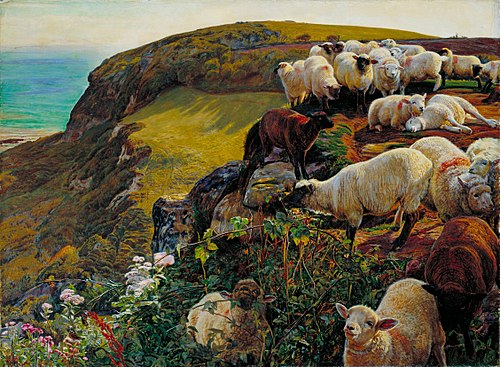Painting
After Holman Hunt's painting The Hireling Shepherd was acquired by William Broderip, this work was commissioned by Broderip's cousin, Charles Theobald Maud, as a reproduction of the sheep in the background. Maud was persuaded to accept a more adventurous composition. He worked en plein air at the location depicted between August and December 1852, despite cold and rainy weather. The painting combines features from different vantage points, with butterflies added in the studio modelled from life. [1]
The painting depicts a flock of sheep lining the picturesque coast of Sussex. The scenic location painted rests on the cliffs at Fairlight Glen, beside Covehust Bay near Hastings, called the Lovers' Seat. [7]
The painting is painted in many layers, with brilliant colours, as many of Hunt's paintings are painted. [8]
It was exhibited at the Royal Academy summer exhibition in 1853 under the title Our English Coasts, but the frame bore the inscription "The Lost Sheep", and it was renamed Strayed Sheep when it was exhibited at the Exposition Universelle in Paris in 1855. It was acquired by the Tate Gallery in 1946, through The Art Fund.
On 30 July 2019, after the British Prime Minister, Boris Johnson visited Wales, cartoonist Steve Bell parodied the painting in The Guardian newspaper. [9]
This page is based on this
Wikipedia article Text is available under the
CC BY-SA 4.0 license; additional terms may apply.
Images, videos and audio are available under their respective licenses.
